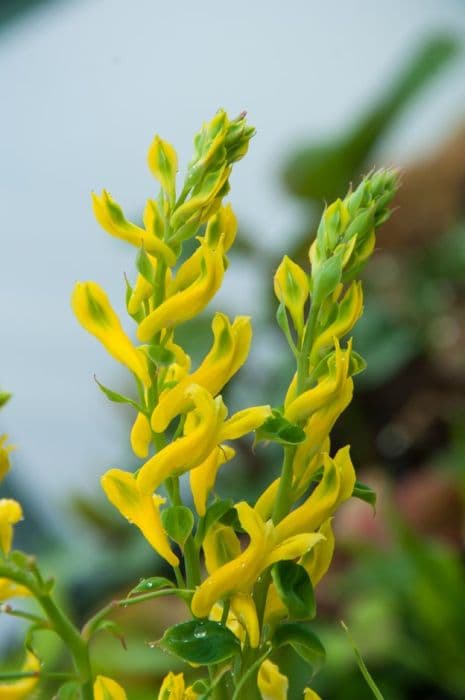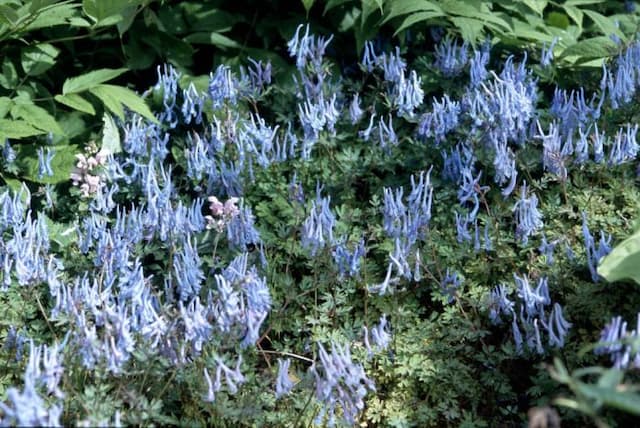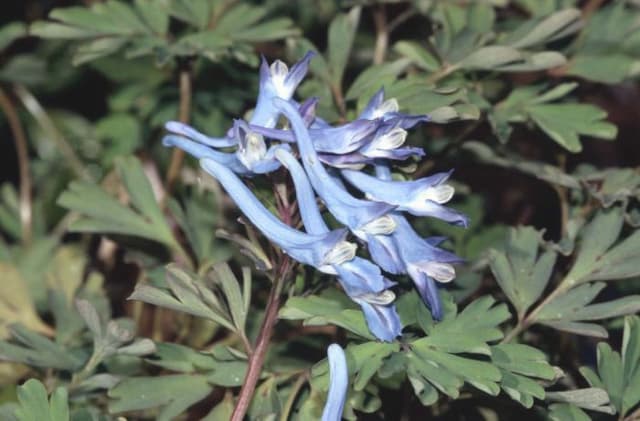Blue Panda Corydalis flexuosa 'Père David'

ABOUT
Corydalis flexuosa 'Père David', commonly known as 'Golden Blue Corydalis', is a herbaceous perennial known for its ornamental qualities. The plant displays delicate, fern-like, blue-green foliage that creates a soft, feathery texture in garden beds. The leaves are divided into smaller leaflets, which in turn are sub-divided to give a finely dissected appearance. One of the most striking features of the Golden Blue Corydalis is its blooms. The flowers emerge in spring and can continue through summer, presenting a remarkable display of vivid, electric blue blossoms. These tubular flowers are slightly curved, resembling a spur at the back, and are clustered atop slender, arching stems, gracefully rising above the foliage. The color contrast between the bright blue flowers and the cool green leaves makes this plant particularly eye-catching. It typically blooms profusely, creating a carpet of color that can enliven shady spots in the landscape. As a perennial, the Golden Blue Corydalis will die back in the winter only to re-emerge with its elegant foliage and charming flowers in the spring, offering a yearly spectacle that enhances woodland settings or shade gardens. It is cherished not only for its beauty but also for its ability to adapt and thrive in dappled shade conditions, where many other colorful plants might struggle.
About this plant
 Names
NamesSynonyms
Blue Panda Corydalis, Pere David's Corydalis, Chinese Corydalis
Common names
Corydalis flexuosa 'Père David'.
 Toxicity
ToxicityTo humans
Blue corydalis is generally not considered highly toxic to humans. While there is limited specific information on its toxicity, plants in the Corydalis genus contain various alkaloids that can potentially cause mild stomach upset if ingested in significant quantities. However, there are no well-documented cases of poisoning from blue corydalis in humans, and it is not typically known as a hazardous plant to humans.
To pets
Blue corydalis is not commonly listed as a poisonous plant for pets. However, as with humans, plants in the Corydalis genus contain alkaloids that can potentially cause gastrointestinal upset if ingested. If a pet were to eat a large amount of blue corydalis, it might experience symptoms such as diarrhea or vomiting. Nonetheless, it's not known to be particularly toxic, and serious consequences are unlikely from casual ingestion. Always monitor pets and prevent them from eating ornamental plants as a precaution.
 Characteristics
CharacteristicsLife cycle
Perennials
Foliage type
Deciduous
Color of leaves
Green
Flower color
Blue
Height
1 foot [30 cm]
Spread
1 foot [30 cm]
Plant type
Herb
Hardiness zones
5
Native area
China
Benefits
 General Benefits
General Benefits- Ornamental Appeal: Corydalis flexuosa 'Père David', commonly known as Blue Panda, adds aesthetic value to gardens with its attractive blue flowers and delicate fern-like foliage.
- Shade Tolerance: Blue Panda is well-suited for shaded areas in the garden, where many other flowering plants might struggle to thrive.
- Spring Bloomer: It is one of the early bloomers in the garden, providing color and interest in the spring when many plants are just emerging.
- Woodland Garden Fit: This plant is an excellent choice for woodland gardens, integrating well with other shade-loving plants to create a naturalistic setting.
- Low Maintenance: Blue Panda requires minimal maintenance once established, making it a good choice for both novice and experienced gardeners.
- Pest Resistance: It is generally resistant to pests, reducing the need for chemical treatments and making it a more environmentally friendly garden choice.
- Attracts Pollinators: The flowers of Blue Panda can attract bees and other pollinators, supporting local ecosystems and biodiversity.
- Seasonal Interest: With its changing foliage color in the fall, Blue Panda adds seasonal interest to the garden beyond the blooming period.
- Good Ground Cover: When planted in groups, Blue Panda can act as an effective ground cover, reducing weed growth and soil erosion.
 Medical Properties
Medical PropertiesThis plant is not used for medical purposes.
 Air-purifying Qualities
Air-purifying QualitiesThis plant is not specifically known for air purifying qualities.
 Other Uses
Other Uses- Corydalis flexuosa 'Père David', also known as Blue Corydalis, can be used in creating natural dyes due to the pigments found in its stems and leaves, offering hues for textiles and craft projects.
- In a garden, Blue Corydalis can be used as a natural pest deterrent because some pests avoid the smell of its foliage.
- The crushed leaves and stems of Blue Corydalis can be used in potpourri mixes for their unique scent that contributes to the fragrance palette.
- During thematic garden displays, Blue Corydalis can represent the color blue for national holidays or sports events where color symbolism is used.
- Blue Corydalis can be used in frost-prone gardens providing an early spring bloom, which assists in gauging the end of frost cycles for other plantings.
- In garden wildlife habitats, Blue Corydalis can provide shelter and a microclimate for beneficial insects, contributing to local biodiversity.
- The plant can also be found in artistic representations such as botanical illustrations, aiding educative purposes on plant morphology.
- Photographers may make use of Blue Corydalis's vivid flowers as a natural backdrop for macro photography works.
- When planting in combination with fall-blooming plants, Blue Corydalis can be used as a "stop-gap" display, ensuring there is no period without blooms.
- Due to its ability to thrive in shady areas, Blue Corydalis can be used to study the adaptation mechanisms of plants in low light conditions.
Interesting Facts
 Feng Shui
Feng ShuiBlue corydalis is not used in Feng Shui practice.
 Zodiac Sign Compitability
Zodiac Sign CompitabilityBlue corydalis is not used in astrology practice.
 Plant Symbolism
Plant Symbolism- Enduring Nature: Corydalis flexuosa 'Père David', commonly known as Chinese Blue Corydalis, often symbolizes the ability to endure and persevere through tough conditions due to its hardy nature and ability to thrive in rocky terrains and woodlands.
- Transience: Reflecting its fleeting flowers that bloom in spring and go dormant by summer, the Chinese Blue Corydalis can represent the ephemeral nature of life and joys.
- Harmony with Nature: With its natural woodland setting, this plant symbolizes a harmonious coexistence with the environment, highlighting the importance of conservation and respect for nature.
 Water
WaterBlue corydalis benefits from regular watering, especially during dry spells, receiving about one inch of water weekly. Water the plant thoroughly to encourage deep root growth, but avoid waterlogging as it prefers well-drained soil. It's best to apply water directly to the base of the plant rather than overhead sprinkling to minimize the risk of leaf diseases. In hot, dry weather, increase watering frequency to prevent the soil from drying out completely. During the winter months, reduce watering as the plant requires less moisture.
 Light
LightBlue corydalis thrives in partial shade, preferably receiving morning sunlight and afternoon shade. The ideal spot for this plant would be a location that is shielded from the intense heat of the midday sun, which can scorch the delicate foliage. Adequate light is essential for optimal growth and flowering, but too much direct sunlight can be harmful.
 Temperature
TemperatureBlue corydalis prefers cool to moderate temperatures, with ideal growth occurring between 50°F and 70°F. The plant can tolerate temperatures as low as 20°F but may suffer if exposed to prolonged periods of frost or temperatures below this threshold. Conversely, high temperatures above 80°F can lead to dormancy; therefore, it is important to provide a cool environment, especially during summer.
 Pruning
PruningBlue corydalis does not typically require extensive pruning, but deadheading spent flowers can encourage a second flush of blooms. Trim away any yellowed or dead foliage to maintain plant health and aesthetics. Pruning is best done after the first flowering in late spring or early summer.
 Cleaning
CleaningAs needed
 Soil
SoilThe Blue Panda Corydalis thrives in rich, moist, well-drained soil with high organic content. A mix of loam, compost, and a small amount of sand can provide the texture and nutrients necessary for its growth. The ideal soil pH for Blue Panda Corydalis should be slightly acidic to neutral, ranging from 6.0 to 7.0.
 Repotting
RepottingBlue Panda Corydalis does not usually require frequent repotting and can be left undisturbed for several years. It should be repotted only when it has outgrown its current container, which may be every 2-3 years.
 Humidity & Misting
Humidity & MistingBlue Panda Corydalis prefers a moderately humid environment, mimicking its native woodland habitat. Aim for a humidity level around 50-60% for the best growth, without the need for special humidity control in typical household conditions.
 Suitable locations
Suitable locationsIndoor
Provide bright, indirect light and keep soil moist.
Outdoor
Plant in part shade, mulch, and keep soil moist.
Hardiness zone
5-9 USDA
 Life cycle
Life cycleThe Blue Panda Corydalis (Corydalis flexuosa 'Père David') starts its life cycle when seeds germinate in the spring, requiring moist, cool conditions to successfully sprout. After germination, seedlings establish themselves and form a clump of fern-like, blue-green foliage. Flowering begins in late spring to early summer, producing clusters of brilliant blue, tubular flowers that attract pollinators. Following pollination, the plant sets seed, which completes its reproduction cycle; these seeds may lie dormant until the next spring. The Blue Panda Corydalis is a perennial plant, meaning it dies back to the ground in winter and re-sprouts from the rootstock in spring. Over time, the plant can slowly spread and colonize an area, thanks to its self-seeding ability and rhizomatous growth habit.
 Propogation
PropogationPropogation time
Spring to early summer
Corydalis flexuosa 'Père David', commonly known as Chinese Blue Corydalis, is most commonly propagated through division of its tubers. This should ideally be done in the fall, after the foliage has died back, or in early spring before growth resumes. To propagate by division, dig up the plant carefully, preserving as much of the root system as possible. Gently separate the tubers, making sure each division has at least one growth bud. Replant the divisions immediately at the same depth they were growing previously, allowing about 12 inches (approximately 30 centimeters) between plants to ensure adequate space for growth. Water the newly planted tubers well to help establish them. This method allows the plant to recover and start new growth with the onset of the next growing season.









